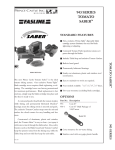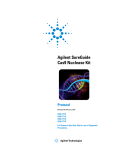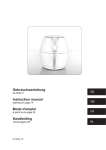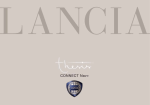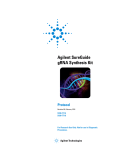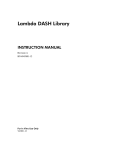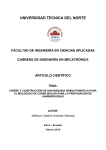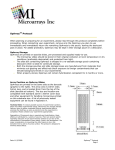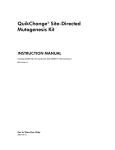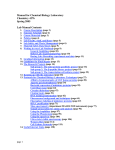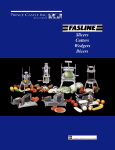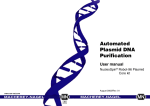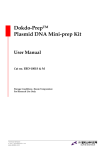Download pBluescript II Phagemid Vectors
Transcript
pBluescript II Phagemid Vectors Instruction Manual Catalog #212205, #212206, #212207 and #212208 Revision C.0 For Research Use Only. Not for use in diagnostic procedures. 212205-12 LIMITED PRODUCT WARRANTY This warranty limits our liability to replacement of this product. No other warranties of any kind, express or implied, including without limitation, implied warranties of merchantability or fitness for a particular purpose, are provided by Agilent. Agilent shall have no liability for any direct, indirect, consequential, or incidental damages arising out of the use, the results of use, or the inability to use this product. ORDERING INFORMATION AND TECHNICAL SERVICES Email [email protected] World Wide Web www.genomics.agilent.com Telephone Location Telephone United States and Canada Austria Benelux Denmark Finland France Germany Italy Netherlands Spain Sweden Switzerland UK/Ireland All Other Countries 800 227 9770 01 25125 6800 02 404 92 22 45 70 13 00 30 010 802 220 0810 446 446 0800 603 1000 800 012575 020 547 2600 901 11 68 90 08 506 4 8960 0848 8035 60 0845 712 5292 Please visit www.genomics.agilent.com and click Contact Us pBluescript II Phagemid Vectors CONTENTS Materials Provided .............................................................................................................................. 1 Storage Conditions .............................................................................................................................. 1 Introduction ......................................................................................................................................... 2 pBluescript II SK (+/–) Phagemids ....................................................................................... 3 pBluescript II KS (+/–) Phagemids ....................................................................................... 4 Ligation into pBluescript II Phagemids ............................................................................................ 5 Transformation with pBluescript II Phagemids .............................................................................. 6 Suggested Host Strain and Genotype .................................................................................... 6 Streaking Cells from a –80°C Bacterial Glycerol Stock ....................................................... 7 Preparation of a –80°C Bacterial Glycerol Stock .................................................................. 7 Blue-White Color Selection .................................................................................................. 7 Background White Colonies.................................................................................................. 8 Screening Colonies .............................................................................................................................. 8 Fixing Replica Sets of Colonies to Nitrocellulose Filters ..................................................... 9 Prehybridization .................................................................................................................. 10 Hybridization ....................................................................................................................... 11 Hybridization Solution ........................................................................................................ 11 Washes................................................................................................................................. 12 Exposure to Film ................................................................................................................. 13 T3 and T7 RNA Transcription......................................................................................................... 13 Handling RNA ..................................................................................................................... 13 Nonspecific Initiation with T7 and T3 RNA Polymerases .................................................. 14 Nonradioactive Transcripts ................................................................................................. 15 DNase Treatment after Transcription .................................................................................. 15 High-Specific-Activity RNA Probes ................................................................................... 15 Transcription Reaction ........................................................................................................ 16 Hybridization Conditions for RNA Probes in Southern Blots ...................................................... 17 Prehybridization .................................................................................................................. 17 Hybridization ....................................................................................................................... 17 Washes................................................................................................................................. 17 Hybridization Conditions for RNA Probes in Northern Blots ...................................................... 17 Prehybridization .................................................................................................................. 17 Hybridization ....................................................................................................................... 17 Washes................................................................................................................................. 17 Recovery of Single-Stranded DNA from Cells Containing pBluescript II Phagemids ............... 18 Single-Stranded Rescue Protocol ........................................................................................ 19 Site-Directed Mutagenesis ................................................................................................................ 20 Plasmid Boiling Miniprep Protocol ................................................................................................. 21 Troubleshooting ................................................................................................................................ 22 Preparation of Media and Reagents ................................................................................................ 22 References .......................................................................................................................................... 23 Endnotes ............................................................................................................................................. 23 MSDS Information ............................................................................................................................ 23 pBluescript II Phagemid Vectors MATERIALS PROVIDED Catalog Number Material Provided #212205 pBluescript II SK(+) phagemid, 1 μg/μl pBluescript II SK(–) phagemid, 1 μg/μl pBluescript II KS(+) phagemid, 1 μg/μl #212206 #212207 #212208 20 μg — — — — 20 μg — — — — 20 μg — pBluescript II KS(–) phagemid, 1 μg/μl — — — 20 μg XL1-Blue MRF´ host strain, glycerol stock, Catalog #200301 1 tube 1 tube 1 tube 1 tube STORAGE CONDITIONS Phagemids: –20°C Bacterial Strains: –80°C Revision C.0 pBluescript II Phagemid Vectors © Agilent Technologies, Inc. 2015. 1 INTRODUCTION The pBluescript II phagemids (plasmids with a phage origin) are cloning vectors designed to simplify commonly used cloning and sequencing procedures, including the construction of nested deletions for DNA sequencing, generation of RNA transcripts in vitro and site-specific mutagenesis and gene mapping. The pBluescript II phagemids have an extensive polylinker with 21 unique restriction enzyme recognition sites. Flanking the polylinker are T7 and T3 RNA polymerase promoters that can 1, 2 be used to synthesize RNA in vitro. The choice of promoter used to initiate transcription determines which strand of the insert cloned into the polylinker will be transcribed. Circular maps and lists of features for the pBluescript II phagemids are shown in figures 1 and 2. The polylinker and T7 and T3 RNA polymerase promoter sequences are present in the N-terminal portion of a lacZ gene fragment. A total of 131 amino acids of β-galactosidase coding sequence is present in the pBluescript II phagemid, but the coding sequence is interrupted by the large polylinker. (There are 36 amino acids from the initiator Met sequence to the EcoR I site.) pBluescript II phagemids having no inserts in the polylinker will produce blue colonies in the appropriate strains of bacteria (i.e., strains containing lacZΔM15 on an F´ episome, such as XL1-Blue MRF´, among others). pBluescript II phagemids that have inserts will produce white colonies using the same strain, because the inserts disrupt the coding region of the lacZ gene fragment. pBluescript II (+) and (–) are available with two polylinker orientations designated as either KS or SK using the following convention: (1) in the KS orientation, the Kpn I restriction site is nearest the lacZ promoter and the Sac I restriction site is farthest from the lacZ promoter; and (2) in the SK orientation, the Sac I site is the closest restriction site to the lacZ promoter and the Kpn I site is the farthest. Flanking the T3 and T7 promoters are BssH II sites. This rare six-base cutter will allow the insert plus the T phage RNA promoters to be excised and used for gene mapping. pBluescript II phagemids can be rescued as single-stranded (ss) DNA. pBluescript II phagemids contain a 454-bp filamentous f1 phage intergenic region (M13 related), which includes the 307-bp origin of replication. The (+) and (–) orientations of the f1 intergenic region allow the rescue of sense or antisense ssDNA by a helper phage. This ssDNA can be used for dideoxynucleotide sequencing (Sanger method) or site-specific mutagenesis. Note 2 We have observed that using excess amounts of EcoR I to digest pBluescript II results in EcoR I prime activity. This appears as cleavage at a non-EcoR I site at the 3´ end of the f1 intergenic region, causing confusion when interpreting results from an agarose gel. If a restriction pattern appears incorrect, check whether reducing the units of EcoR I restores a normal restriction pattern. pBluescript II Phagemid Vectors pBluescript II SK (+/–) Phagemids f1 (-) ori f1 (+) ori ampicillin lacZ' Kpn I pBluescript II SK (+/-) MCS Sac I 3.0 kb P lac pUC ori pBluescript II SK (+/–) Multiple Cloning Site Region (sequence shown 598–826) T7 Promoter BssH II Kpn I Apa I EcoO109 I Dra II Xho I Hinc II Acc I Sal I TTGTAAAACGACGGCCAGTGAGCGCGCGTAATACGACTCACTATAGGGCGAATTGGGTACCGGGCCCCCCCTCGAGGTCGAC... M13 –20 primer binding site Bsp106 I Hind III Cla I KS primer binding site... T7 primer binding site EcoR V EcoR I Pst I Sma I BamH I Spe I Xba I Not I Eag I BstX I Sac II Sac I ...GGTATCGATAAGCTTGATATCGAATTCCTGCAGCCCGGGGGATCCACTAGTTCTAGAGCGGCCGCCACCGCGGTGGAGCTC... ...KS primer binding site SK primer binding site T3 Promoter BssH II β-gal α-fragment ...CAGCTTTTGTTCCCTTTAGTGAGGGTTAATTGCGCGCTTGGCGTAATCATGGTCATAGCTGTTTCC T3 primer binding site M13 Reverse primer binding site Feature Nucleotide Position f1 (+) origin of ss-DNA replication [pBluescript SK (+) only] 135–441 f1 (–) origin of ss-DNA replication [pBluescript SK (–) only] 21–327 β-galactosidase α-fragment coding sequence (lacZ’) 460–816 multiple cloning site 653–760 T7 promoter transcription initiation site 643 T3 promoter transcription initiation site 774 lac promoter 817–938 pUC origin of replication 1158–1825 ampicillin resistance (bla) ORF 1976–2833 FIGURE 1 The pBluescript II SK (+/–) phagemid vectors. The complete sequence and list of restriction sites are available at www.genomics.agilent.com. Genbank® #X52328 [SK(+)] and #X52330 [SK(–)]. pBluescript II Phagemid Vectors 3 pBluescript II KS (+/–) Phagemids f1 (-) ori f1 (+) ori ampicillin lacZ' Sac I MCS pBluescript II KS (+/-) Kpn I 3.0 kb P lac pUC ori pBluescript II KS (+/–) Multiple Cloning Site Region (sequence shown 598–826) T7 Promoter BssH II Sac I Not I Eag I BstX I Sac II Xba I TTGTAAAACGACGGCCAGTGAGCGCGCGTAATACGACTCACTATAGGGCGAATTGGAGCTCCACCGCGGTGGCGGCCGCTCTAGA... M13 –20 primer binding site Spe I BamH I Sma I T7 primer binding site Pst I EcoR I EcoR V Hind III Bsp106 I Cla I Hinc II Acc I Sal I Xho I SK primer binding site... Apa I EcoO109 I Kpn I Dra II ...ACTAGTGGATCCCCCGGGCTGCAGGAATTCGATATCAAGCTTATCGATACCGTCGACCTCGAGGGGGGGCCCGGTACC... KS primer binding site ...SK primer binding site T3 Promoter BssH II β-gal α-fragment ...CAGCTTTTGTTCCCTTTAGTGAGGGTTAATTGCGCGCTTGGCGTAATCATGGTCATAGCTGTTTCC T3 primer binding site M13 Reverse primer binding site Feature Nucleotide Position f1 (+) origin of ss-DNA replication [pBluescript KS (+) only] 135–441 f1 (–) origin of ss-DNA replication [pBluescript KS (–) only] 21–327 β-galactosidase α-fragment coding sequence (lacZ’) 460–816 multiple cloning site 653–760 T7 promoter transcription initiation site 643 T3 promoter transcription initiation site 774 lac promoter 817–938 pUC origin of replication 1158–1825 ampicillin resistance (bla) ORF 1976–2833 FIGURE 2 The pBluescript II KS (+/–) phagemid vectors. The complete sequence and list of restriction sites are available at www.genomics.agilent.com. Genbank® #X52327 [KS(+)] and #X52329 [KS(–)]. 4 pBluescript II Phagemid Vectors LIGATION INTO PBLUESCRIPT II PHAGEMIDS Dephosphorylate the digested pBluescript II phagemid with calf intestinal alkaline phosphatase (CIAP) prior to ligation with the insert DNA. If more than one restriction enzyme is used, the background can be reduced further by electrophoresing the digested vector DNA on an agarose gel and recovering the desired vector band through electroelution, leaving behind the small fragment that appears between the two restriction enzyme sites. After gel purification and ethanol precipitation of the DNA, resuspend in a volume of TE buffer [5 mM Tris (pH 7.5), 0.1 mM EDTA] that will allow the concentration of the vector DNA to be the same as the concentration of the insert DNA (~0.1 μg/μl). For ligation, the ideal ratio of insert to vector DNA is variable; however, a reasonable starting point is 2:1 (insert:vector), measured in available picomole ends. This is calculated as: picomole ends/micrograms of DNA = (2 × 106) ÷ (number of base pairs × 660) We suggest the following protocol, which includes three controls: Component 1 2 3 4 5 Prepared vector (0.1 μg/μl) 1 μl 1 μl 1 μl 1 μl 0 μl Prepared insert (0.1 μg/μl) X μl X μl 0 μl 0 μl 1 μl 10 mM rATP (pH 7.0) 1 μl 1 μl 1 μl 1 μl 1 μl 10× Ligase buffer 1 μl 1 μl 1 μl 1 μl 1 μl T4 DNA ligase (4 U/μl) 0.5 μl 0.5 μl 0.5 μl 0 μl 0.5 μl ddH2O (to 10 μl) X μl X μl X μl X μl X μl 1. Ligate for 2 hours at room temperature (22°C) or overnight at 4°C. When ligating blunt ends, incubate the ligation overnight at 12–14°C. 2. Transform 1–2 μl of the ligation mix into the appropriate competent bacteria. (See Transformation with pBluescript II Phagemids.) Plate on selective media. 3. Interpretation of test results: Reactions 1 and 2 vary the insert:vector ratio. Control 3 tests for the effectiveness of the CIAP treatment. Control 4 indicates if the vector was cleaved completely or if residual uncut vector remains. Control 5 verifies that the insert alone is not contaminated with any vector DNA. pBluescript II Phagemid Vectors 5 4. Expected plating results: Plates 1 and 2 should have mostly white colonies, representing recombinants. Plate 3 should have low numbers of blue colonies if the CIAP treatment was effective. Plate 4 should have no colonies if the digest was complete. Plate 5 should have no colonies if the insert was pure. TRANSFORMATION WITH PBLUESCRIPT II PHAGEMIDS Note pBluescript II phagemids will replicate autonomously as plasmids. Therefore, colonies—not plaques—are obtained following transformation. Suggested Host Strain and Genotype The XL1-Blue MRF´ host strain is recommended for propagation of pBluescript II phagemids and for transformation of recombinant phagemids. XL1-Blue MRF´ allows blue-white color selection and single-stranded DNA rescue, and is restriction-deficient aiding in the construction of libraries 3 made from methylated DNA. XL1-Blue MRF´ Genotype: Δ(mcrA)183 Δ(mcrCB-hsdSMR-mrr)173 endA1 supE44 thi-1 recA1 gyrA96 relA1 lac [F´ proAB lacIqZΔM15 Tn10 (Tetr)] Note The XL1-Blue MRF´ is provided as a glycerol stock. Additional tubes of glycerol stock are available for purchase (Catalog #200301). Alternatively, high-efficiency XL1-Blue MRF´ frozen competent cells are also available (>1 × 109 colonies/μg of pUC 18, Catalog #200230). For the appropriate media and plates for growth of XL1-Blue MRF´, please refer to the following table: Bacterial strain Plates for bacterial streak Media for glycerol stock XL1-Blue MRF´ LB–tetracycline agara LB–tetracyclinea a12.5 6 μg/ml tetracycline. pBluescript II Phagemid Vectors Streaking Cells from a –80°C Bacterial Glycerol Stock Prepare the following from a frozen glycerol stock: Note Do not allow the contents of the vial to thaw. The vials can be stored at –20° or –80°C, but most strains remain viable longer if stored at –80°C. 1. Revive the stored cells by scraping off splinters of solid ice with a sterile wire loop. 2. Streak the splinters onto an LB plate containing the appropriate antibiotic. Restreak the cells fresh each week. Preparation of a –80°C Bacterial Glycerol Stock 1. In a sterile 50-ml conical tube, inoculate 10 ml of the appropriate liquid media with one or two colonies from a plate of freshly-streaked cells. Grow the cells to late log phase. 2. Add 4.5 ml of a sterile glycerol–liquid media solution (prepared by combining 5 ml of glycerol + 5 ml of liquid media) to the bacterial culture from step 1. Mix well. 3. Aliquot into sterile centrifuge tubes (1 ml/ tube). This preparation may be stored at –20°C for 1–2 years or at –80°C for more than 2 years. Blue-White Color Selection The XL1-Blue MRF´ strain allows blue–white color selection for pBluescript II phagemids because of lacZΔM15 complementation on the F´ episome. The color selection may be seen when plating on LB plates containing 100 μg/ml of ampicillin, 80 μg/ml of fresh X-gal, and 20 mM IPTG. Alternatively, plates for color selection can be prepared by spreading 100 μl of 40 mM IPTG and 100 μl of 2% X-gal on LB–ampicillin plates 30 minutes prior to plating your transformants. X-gal should be prepared in dimethyl formamide and IPTG in sterile, distilled H2O (store stock solutions at –20°C until use). Colonies containing phagemids without inserts will be blue after incubation for 12–18 hours at 37°C. Colonies with phagemids containing inserts will remain white. Further enhancement of the blue color may be obtained by placing plates at 4°C for 2 hours following overnight growth at 37°C. Occasionally, β-galactosidase fusion proteins are toxic to the host bacteria. If there is any suspicion that an insert might be toxic, the X-gal and IPTG may be left out of the ampicillin plates. Under these conditions there will be no color selection, but recombinants will express lower levels of the potentially toxic proteins. pBluescript II Phagemid Vectors 7 Background White Colonies Since the ΔM15 lac gene carried on the F´ episome is needed for the blue– white color assay, host bacteria that have lost the F´ episome will remain as white colonies on an X-gal/IPTG agar plate even if the pBluescript II phagemid does not contain an insert. XL1-Blue MRF´ is a lac– AG1 derivative with Tn10, lacIq, and lacZΔM15 on the F´. Selection for bacteria containing the F´ in this strain is accomplished by plating on 12.5 μg/ml tetracycline instead of minimal media plates. XL1-Blue MRF´ transformants containing pBluescript II phagemids can be plated on tetracycline– ampicillin plates to select for colonies that contain both the F´ and the pBluescript II phagemid. This advantage further reduces the background of false positives. For bacteria containing an F´ without a Tn10 gene, growth on a minimal medium plate supplemented with 1 mM thiamine-HCl will maintain selection for the F´; however, colonies will grow more slowly. If there is any doubt about whether a white colony represents a pBluescript II recombinant or a colony lacking the F´, streak it onto a minimal medium 4 plate. A cell lacking an F´ will not grow; an F+ will grow slowly since it carries the proAB genes on the F´ episome. SCREENING COLONIES Colonies containing pBluescript II phagemids may be screened for recombinants by double-stranded DNA, RNA, or oligonucleotide 5 hybridization. Colonies may also be screened by restriction mapping or by sequencing miniprep plasmid DNA. Antibodies may be used to screen 6 colonies since cDNA cloned into the appropriate reading frame of the lacZ gene will be expressed as fusion proteins. When screening with antibodies, the bacteria produce fusion proteins containing several amino acids from the amino-terminus of the β-galactosidase protein (3.5 kDa to the EcoR I site). Some fusion proteins are toxic to E. coli. Therefore, it is best to initially plate transformants on nitrocellulose filters on top of ampicillin plates lacking IPTG. After 8–10 hours (when the colonies are 1 mm in diameter), transfer the filters to plates containing 5 mM IPTG for several hours. This will induce synthesis of the fusion proteins. When screening with antibodies, the Agilent picoBlue immunoscreening kit is recommended. To synthesize large amounts of the fusion proteins in liquid culture, grow the cells to an OD600 = 0.7 in the absence of IPTG. Add IPTG to 5 mM and grow for another 2–3 hours. The β-galactosidase portion of the fusion protein is ~3.5 kDa from the Met amino acid to the EcoR I site in the polylinker. Identification of recombinant clones within pBluescript II can be performed by colony hybridization. The following protocol minimizes problems associated with colony screening procedures. For the following protocol to be effective, the screening should be performed on duplicate sets of filters. 8 pBluescript II Phagemid Vectors Fixing Replica Sets of Colonies to Nitrocellulose Filters Use the following protocol to make multiple replica plates of transformants. Keep the original or master filter to pick colonies identified by the screening of the replica filters. 1. Place 100–mm Duralon–UV or nitrocellulose filters on 150–mm LB– ampicillin plates. 2. Spread ~1.0 × 106 cfu on the filters. 3. Incubate the plates at 37°C overnight or until colonies are 1.0 mm in diameter (~7–10 hours). 4. Make a replica of the library growing on the nitrocellulose filter: 5. pBluescript II Phagemid Vectors a. Place a piece of sterile Whatman® 3MM paper on a glass surface. b. Remove the filter from the agar and place it colony side up on the Whatman 3MM paper. c. Align a fresh filter, prewetted on an LB plate, over the master filter and cover with another piece of Whatman 3MM paper. Press in place with a glass plate. d. Mark the filters with a small needle to aid in realignment after hybridization. e. Separate the master and replica filters and place face up on LB agar plates containing ampicillin. f. Incubate both the master and replica filters for at least 4 hours at 37°C. g. Seal the master plate with Parafilm® and store at 4°C. The replica filter is then prepared for hybridization: a. Place the replica filter colony side up for 30 seconds on the surface of Whatman 3MM paper prewetted with 0.5 M NaOH. b. Remove filter and place on another sheet of Whatman 3MM paper prewetted with 1 M Tris-HCl (pH 7.6) for 30 seconds. c. Remove the filter and place on a third piece of Whatman 3MM paper prewetted with 1 M Tris-HCl (pH 7.6) and 1.5 M NaCl for 30 seconds. d. Immerse the filter in 1 M Tris-HCl (pH 7.6) and 1.5 M NaCl and remove bacterial debris by rubbing the filter gently with a gloved hand. 9 e. Rinse the filter in 1 M Tris-HCl (pH 7.6) and 1.5 M NaCl. Blot dry on paper towels. f. Crosslink the DNA to the filters using the autocrosslink setting on the Stratalinker UV crosslinker (120,000 μJ of UV energy). Alternatively, oven-bake at 80°C for ~1.5–2 hours. Prehybridization Prehybridization Solution for Oligonucleotide Probe 6× SSC 20 mM NaH2PO4 0.4% sodium dodecyl sulfate* (SDS) 5× Denhardt's Denatured, sonicated salmon sperm DNA (500 μg/ml) OR Prehybridization Solution for Double-Stranded Probe 2× Pipes buffer 50% Deionized formamide 0.5% SDS* Denatured, sonicated salmon sperm DNA (100 μg/ml) The amount of prehybridization solution to make is dependent on the number of filters used (generally 2–3 ml/membrane). 1. Preheat the prehybridization solution to ~50°C without the salmon sperm DNA. Preboil the salmon sperm DNA for ~10 minutes and add it to the warm prehybridization solution. 2. Wet each filter (quickly) in the prehybridization buffer in a tray, placing each filter on top of the next, until each is wet through. Add more prehybridization solution as necessary. (This helps wet the filters completely to allow more even hybridization later.) 3. Put the wet prehybridization filter "stack" in a heat-seal bag, add the remaining prehybridization buffer and heat seal. 4. Calculate the hybridization temperature (generally 42°C) and prehybridize for a minimum of 1 hour. 5. Prehybridize and hybridize a blank filter ("background") along with the rest and wash it to determine when and at what temperature the background counts disappear. * For Stratagene Duralon-UV membranes, increase the SDS concentration to 1% (w/v). 10 pBluescript II Phagemid Vectors Hybridization Labeling Oligonucleotide Probes Label oligonucleotides with fresh [γ-32P]ATP. High-specific-activity γ-label yields the best results. a. Perform a polynucleotide kinase (PNK) labeling in 1× ligase buffer for 30 minutes at 37°C. b. Incubate for 15 minutes at 65°C to inactivate the kinase. c. Run the solution over a G-50 column to get rid of the unincorporated counts. Labeling Double-Stranded Probes When using double-stranded probes, nick translate with fresh [α-32P]dATP. Alternatively, we offer the Prime-It II random primer labeling kit. designed to produce high-specific-activity DNA probes in 2 minutes. It is best to use ~1 × 106–5 × 106 counts/ml of hybridization solution. Keep the concentration of counts high and use ~1 × 107 counts/filter. Hybridization Solution Hybridization Solution for Oligonucleotide Probes 6× SSC 20 mM NaH2PO4 0.4% SDS* Denatured, sonicated salmon sperm DNA (500 μg/ml) 1. Make the hybridization solution. 2. Boil the salmon sperm DNA and then add it to the prewarmed hybridization solution. 3. Pour out the prehybridization buffer from the filter bag. Add the hybridization solution and then the appropriate amount of labeled oligonucleotide. * For Stratagene Duralon-UV membranes, increase the SDS concentration to 1% (w/v). pBluescript II Phagemid Vectors 11 4. Heat seal and hybridize at 5–10°C below Tm. Calculate Tm using the following formula: Note The first method below overestimates the Tm of hybrids involving longer nucleotides. OLIGONUCLEOTIDES SHORTER THAN 18 BASES Tm = 2°C(A + T) + 4°C(G + C) OLIGONUCLEOTIDES 14 BASES AND LONGER (UP TO 60–70 NUCLEOTIDES) Tm = 81.5 – 16.6 (log10[Na+]) + 0.41(%G + C) – (600/N), where N = chain length Hybridization Solution for Double-Stranded Probes 2× Pipes buffer 50% Deionized formamide 0.5% SDS* Denatured, sonicated salmon sperm DNA (100 μg/ml) 1. Prepare the hybridization solution. 2. Warm the solution, boil the appropriate amount of salmon sperm DNA with the probe for 4 minutes and then add it to the hybridization buffer. 3. Decant the prehybridization buffer and replace it with the hybridization solution and probe. Hybridize overnight at 42°C. Washes Oligonucleotide Probes Use 6× SSC buffer and 0.1% (w/v) SDS. Wash the filters three times for 5 minutes each at room temperature. The final washing temperature depends on the GC ratio of the probe. It is best to stay several degrees below the melting temperature. A rough estimate of the melting temperature of an oligonucleotide probe can be determined by the following formula: Tm = 4(G + C) + 2(T + A) If the probe sequence is unknown, start with a room temperature wash and gradually increase the temperature until the background diminishes. DO NOT allow the membranes to completely dry out or the probe may be irreversibly bound. Double-Stranded Probes Use 0.1× SSC buffer and 0.1% (w/v) SDS. Wash the filters at 50–65°C with agitation. * For Stratagene Duralon-UV membranes, increase the SDS concentration to 1% (w/v). 12 pBluescript II Phagemid Vectors Exposure to Film After washing, remove the excess liquid by blotting on Whatman 3MM paper and place the filters between two sheets of plastic wrap in cassettes with intensifying screens. Leave overnight at –80°C. (By keeping the filters slightly moist between plastic wrap, you can wash again if the background is high.) T3 AND T7 RNA TRANSCRIPTION The RNA transcripts synthesized from inserts cloned into vectors containing either T3 or T7 polymerase promoters can be used for many purposes. Transcripts can be used for both Southern and Northern hybridization experiments and for either S1 or RNase A analysis. In addition, RNA transcripts can be used to produce protein by translation in vitro or translation in vivo after microinjection into Xenopus oocytes or tissue culture cells. The pBluescript II vectors have a BssH II site outside each RNA promoter. This feature allows the excising of the insert with the promoters and subsequent mapping using phosphorylated T3 and/or T7 primers. Handling RNA Note Wear gloves at all times to prevent RNase contamination. When working with RNA, caution must be used to eliminate RNase contamination from any source. The following general principles will help in the production of full-length transcripts: 1. Make all buffers, DTT, and rNTPs in highly pure water treated with diethylpyrocarbonate (DEPC) as follows: Add DEPC to water to a final concentration of 0.1%, heat to 37°C for 8 hours and autoclave. If DEPC scent remains after autoclaving, place the water in a 90°C water bath for at least 1 hour or until the scent is gone. Note Do not treat Tris solutions with DEPC!! Instead, use water that has been treated with DEPC to make up all Tris solutions. The Agilent RNAMaxx high-yield transcription kit (Catalog #200339) may be used for transcription reactions performed with T7 RNA polymerase. pBluescript II Phagemid Vectors 13 2. All tubes and pipet tips should be autoclaved and baked for several hours at 80°C. A common source of RNase contamination on gel electrophoresis equipment comes from DNA minipreps which have been treated with RNase A. Thoroughly clean all gel tanks, gel combs, gel spacers and glassware, using soap and water followed with an ethanol rinse. Next, soak the equipment in 3% hydrogen peroxide for 10 minutes at room temperature and rinse with DEPC-treated water. Keep cleaned items covered and away from bare hands. Autoclave all glass plates and other appropriate materials on dry cycle prior to use. 3. Phagemid templates for transcription must be RNase-free. Cesium chloride preps are advisable, but minipreps may be used if care is taken to remove contaminating RNases. Generally the plasmid template is linearized with an enzyme that cleaves "downstream" of the RNA polymerase promoter and the insert in the multiple cloning site. It is strongly advised to purify the post-restriction digest DNA by adding 50 μg/ml proteinase K to the restriction buffer at 37°C for 30 minutes, followed by two phenol–chloroform [1:1 (v/v)] extractions and ethanol precipitation prior to the transcription reaction. Resuspend digested, proteinase K treated DNA at 1 mg/ml in a 10 mM Tris (pH 7.4) and 0.1 mM EDTA solution made with DEPC-treated water. 4. Working with RNA is simplified by using a ribonuclease inhibitor in transcription reactions. The Agilent RNase Block Ribonuclease Inhibitor has been tested and adjusted to work optimally with Agilent’s transcription kits. Nonspecific Initiation with T7 and T3 RNA Polymerases T7 and T3 RNA polymerases are highly specific for their respective 1 promoters, however, nonspecific initiation of RNA transcripts may occur at the ends of the DNA template. This is most prevalent with a 3´-protruding terminus. Nonspecific initiation may be reduced by increasing the NaCl concentration in the transcription buffers to 100 mM, although this will result in a decrease of the total transcription efficiency by ~50%. When possible, use restriction enzymes that leave blunt or 5´-protruding ends. When the T7 or T3 polymerase enzymes are used in molar excess of the DNA template, there is a risk of polymerization from the wrong promoter. T7 polymerase can synthesize RNA inefficiently from a plasmid containing only a T3 promoter. Conversely, T3 polymerase can synthesize RNA inefficiently from a plasmid containing only a T7 promoter. Synthesis is extremely promoter specific when both promoters are present, provided that the enzyme is not in molar excess of the specific promoter. Do not use excessive amounts of the polymerases if promoter specificity is important to your experiment. Best results are obtained when the ratios stated in this manual are followed. 14 pBluescript II Phagemid Vectors Nonradioactive Transcripts Nonradioactive transcripts can be used for nucleotide sequencing, in vitro translation and injection into cells for in vivo translation. Set up the transcription reaction as described, but add 1 μl of 10 mM rUTP instead of radioactive rUTP. For larger amounts of RNA, scale up the reaction appropriately. Each molecule of DNA template yields 10–20 nonradioactive RNA molecules if the ribonucleotides are not a limiting factor. DNase Treatment after Transcription The DNA template will be present after the transcription reaction and can be removed with RNase-free DNase. After the transcription reaction, add 10 U of RNase-free DNase/μg of DNA template and incubate at 37°C for 15 minutes. Extract with phenol–chloroform [1:1 (v/v)], add 1/10 volume of 3 M sodium acetate at pH 5.2 and precipitate RNA with 2.5 volumes of 100% (v/v) ethanol. High-Specific-Activity RNA Probes Any vector containing T3 and T7 RNA promoters can be used to synthesize high specific activity, strand-specific RNA probes. The choice between T3 and T7 RNA polymerase will determine which strand will be used as the template. This is important because probes used for Northern or S1 analysis must complement the RNA targeted for detection. The initiation of RNA transcription requires rGTP; the reaction has a Km of ~180 μM. The elongation reaction has a Km of 40 μM for each ribonucleotide. Therefore, radioactive rGTP should not be used to generate high specific-activity probes unless the concentration of rGTP exceeds 180 μM. This usually means supplementing the radioactive rGTP with cold rGTP. Adding 50 μCi of 500 Ci/mmol [32P]rXTP to a 25-μl reaction only produces an rXTP concentration of 4 μM. To generate high specific-activity probes, we suggest using radioactive rATP, rCTP, or rUTP as the labeled nucleotide. However, any triphosphate present at just 4 μM will not produce many transcripts per template molecule because the reaction simply runs out of radioactive rXTP. To make large amounts of long, radioactive transcripts, the reactions must be supplemented with cold rXTP. It is therefore necessary to choose between full length, quantity and high-specific-activity when producing probes. pBluescript II Phagemid Vectors 15 Transcription Reaction Note The RNAMaxx high-yield transcription kit (Catalog #200339) may be used for transcription reactions performed with T7 RNA polymerase. 1. In the order given, add 5 μl of 5× transcription buffer§ 1 μg of restricted, proteinase K-treated DNA template 1 μl of 10 mM rATP 1 μl of 10 mM rCTP 1 μl of 10 mM rGTP [1 μl of 1 mM rUTP is optional (see above)] 1 μl of 0.75 M dithiothreitol (DTT) 1 μl of RNase Block Ribonuclease Inhibitor (optional) 5 μl of 400–800 Ci/mmol, 10 μCi/μl [α-32P]rUTP 10 U of T3 or T7 RNA polymerase* DEPC-treated water to a final volume of 25 μl 2. Incubate at 37°C for 30 minutes. 3. RNA transcripts may be purified away from the unincorporated nucleotides using an RNase-free G-50 column.Take care to prevent the presence ribonucleases in the column that could degrade the probe. Note Do not use large excesses of T3 polymerase (10 U of polymerase per pmol of promoter is sufficient). T3 RNA polymerase may utilize the T7 promoter 1 in 20 times when the T3 enzyme concentration exceeds the T3 promoter concentration by 10-fold. However, T3 polymerase in the recommended concentrations will not make T7 transcripts in the presence of a T3 promoter. If any T7 hybridization should result from a T3 transcription, decrease the amount of T3 polymerase by a factor of 5 or 10. § See Preparation of Media and Reagents. * Use supplied RNA polymerase dilution buffer to dilute enzymes just before use. 16 pBluescript II Phagemid Vectors HYBRIDIZATION CONDITIONS FOR RNA PROBES IN SOUTHERN BLOTS Prehybridization Prehybridize the membrane with 0.1–0.5 ml/cm2 of the following solution for 2 hours at 42°C with constant agitation in a heat-sealable bag: 6× SSC 5× Denhardt’s (see Preparation of Media and Reagents) 20 mM NaH2PO4 500 μg/ml of denatured, sonicated salmon sperm DNA Hybridization Pour off the prehybridization solution and add the probe to the bag with the minimum volume of the following hybridization solution: 6× SSC 20 mM NaH2PO4 0.4% SDS* 500 μg/ml denatured sonicated salmon sperm DNA Incubate overnight at 42°C with constant agitation. Washes Wash in 2× SSC buffer and 0.1% (w/v) SDS twice for 15 minutes each at 55°C and twice in 0.1× SSC buffer and 0.1% (w/v) SDS for 15 minutes each at 55°C. HYBRIDIZATION CONDITIONS FOR RNA PROBES IN NORTHERN BLOTS Prehybridization Prehybridize the membrane with 0.1–0.5 ml/cm2 of the following solution for ~1 hour at 42°C with constant agitation in a heat-sealable bag: 50% deionized formamide 10% dextran sulfate 1% SDS* 1 M NaCl 100 μg/ml of denatured sonicated salmon sperm DNA Hybridization Hybridize overnight with the riboprobe at the same temperature and in the prehybridization solution. Washes Wash in 2× SSC buffer and 0.1% (w/v) SDS twice for 15 minutes each at 42°C and twice in 0.1× SSC buffer and 0.1% (w/v) SDS for 15 minutes each at 42°C. If a high background is observed, the temperature may be increased or the NaCl concentration may be decreased for greater stringency. * For Stratagene Duralon-UV and Illuminator membranes, increase the SDS concentration to 1% (w/v). pBluescript II Phagemid Vectors 17 RECOVERY OF SINGLE-STRANDED DNA FROM CELLS CONTAINING PBLUESCRIPT II PHAGEMIDS pBluescript II is a phagemid that can be secreted as single-stranded DNA in the presence of M13 helper phage. These phagemids contain the intergenic (IG) region of a filamentous f1 phage. This region encodes all of the cis-acting functions of the phage required for packaging and replication. In E. coli with the F+ phenotype (containing an F´ episome), pBluescript II phagemids will be secreted as single-stranded f1 "packaged" phage when the bacteria has been infected by a helper phage. Since these filamentous helper phages (M13, fI) will not infect E. coli without an F´ episome coding for pili, it is essential to use XL1-Blue MRF´ or a similar strain containing the F´ episome.7, 8 pBluescript II phagemids are offered with the IG region in either of two orientations: pBluescript II (+) is replicated such that the sense strand of the β-galactosidase gene is secreted within the phage particles; pBluescript II(–) is replicated such that the antisense strand of the β-galactosidase gene is secreted in the phage particles. We offer helper phages that preferentially package pBluescript II phagemids. Typically, 30–50 pBluescript II molecules are packaged/helper phage DNA molecule. Yields of single-stranded (ss)DNA depend on the specific insert sequence. For most inserts, over 1 μg of ssDNA can be obtained from a 1.5-ml miniprep if grown in XL1-Blue MRF´. A faint single-strand helper phage band may appear on a gel at ~4 kb for R408 or at 6 kb for VCSM13. This DNA mixture can be sequenced with primers that are specific for pBluescript II and do not hybridize to the helper phage genome. Site-specific mutagenesis is also possible using standard techniques. The advantages of using pBluescript II phagemids for either purpose are as follows: (1) pBluescript II phagemids do not replicate via the M13 cycle, lessening the tendency to delete DNA inserts, therefore it is unlikely that even 10-kb inserts will be deleted. (2) "Packaging" of pBluescript II phagemids containing inserts is efficient since the pBluescript II vector is significantly smaller than wild-type M13. (3) Oligonucleotide mutagenesis in pBluescript II vectors is advantageous because the mutagenized insert is located between the T3 and T7 promoters. The resultant mutant transcripts can be synthesized in vitro without further subcloning. VCSM13 and R408 helper phage produce the largest amount of singlestrand pBluescript II. R408 (single-strand size ~4 kb) is more stable and can be grown more easily. VCSM13 (single-strand size ~6 kb), is more efficient at single-stranded DNA rescue and yields more single-stranded phagemid; however it is more unstable and reverts to wild-type more frequently. This difficulty can be addressed by periodically propagating VCSM13 in the presence of kanamycin. VCSM13 (a derivative of M13KO7) has a kanamycin gene inserted into the intergenic region, while R408 has a deletion in that region. We suggest R408 for excision of pBluescript II from the Lambda ZAP vector and VCSM13 for single-stranded rescue. 18 pBluescript II Phagemid Vectors Single-Stranded Rescue Protocol 1. Inoculate a single colony into 5 ml of 2× YT containing 100 μg/ml ampicillin and VCM13 or R408 helper phage at 107–108 pfu/ml (MOI ~10). 2. Grow the culture at 37°C with vigorous aeration for 16–24 hours, or until growth has reached saturation. Note If using VCSM13, after 1–2 hours, add kanamycin to 70 μg/ml to select for infected cells. 3. Centrifuge 1.5 ml of the cell culture for 5 minutes in a microcentrifuge. 4. Remove 1 ml of the supernatant to a fresh tube, then add 150 μl of a solution containing 20% PEG8000 and 2.5 M NaCl. Allow phage particles to precipitate on ice for 15 minutes. Note For increased yield, perform the PEG precipitation overnight at 4°C. 5. Centrifuge for 5 minutes in a microcentrifuge. (A pellet should be obvious.) 6. Remove supernatant. Centrifuge the PEG pellets a few seconds more to collect residual liquid, then remove and discard the residual liquid. 7. Resuspend the pellet in 400 μl of 0.3 M NaOAc (pH 6.0) and 1 mM EDTA by vortexing vigorously. 8. Extract with 1 volume phenol–chloroform and centrifuge for 1–2 minutes to separate phases. 9. Transfer the aqueous phase to a fresh tube and add 1 ml of ethanol. Centrifuge for 5 minutes. 10. Remove ethanol and dry the DNA pellet. 11. Dissolve the pellet in 25 μl of TE buffer. 12. Analyze 1–2 μl on an agarose gel. pBluescript II Phagemid Vectors 19 SITE-DIRECTED MUTAGENESIS Isolated single-stranded DNA (see Recovery of Single–Stranded DNA from Cells Containing pBluescript II Phagemids) can be used for site-directed 9 oligonucleotide mutagenesis. The following protocol is recommended: 1. Phosphorylation of the oligonucleotide with polynucleotide kinase: 100 ng of oligonucleotide 4 μl of 10× ligase buffer§ 4 μl of 10 mM rATP 2 μl of polynucleotide kinase (10 U) Water to 40 μl final volume Incubate at 37°C for 30 minutes. 2. Synthesis of mutant DNA strand a. Anneal Oligonucleotide 20 μl of oligonucleotide from the kinase reaction (50 ng) 5 μl of salmon sperm DNA (1 μg template) Incubate at 65°C for 10 minutes, then at room temperature for 5 minutes. b. 3. Transform XL1-Blue MRF´ E. coli with 10 μl of synthesis reaction and plate onto nitrocellulose filters across three plates. 4. Screen as described in Screening Colonies. One percent mutants should be obtained. § 20 Primer Extension Reaction Add the following to the annealing reaction: 4.0 μl of 10× ligase buffer§ 2.0 μl of 2.5 mM dNTPs (N = A, C, G and T in equal concentration) 4.0 μl of 10 mM rATP 1.0 μg of single-stranded DNA binding protein 1.5 U of Klenow 0.5 μl of T4 DNA ligase (2 U) Water to 40 μl final volume Incubate at room temperature for 3–4 hours. See Preparation of Media and Reagents. pBluescript II Phagemid Vectors PLASMID BOILING MINIPREP PROTOCOL The following protocol yields high-quality dsDNA template simply and rapidly. (Caution: Escherichia coli strain HB101 and derivatives give low yields using this protocol.) This DNA is suitable for restriction enzyme 10 digestion or for enzyme sequencing. 1. Grow a 3-ml culture overnight in LB broth plus ampicillin (100 μg/ml) from a single colony. 2. Pellet 1.5 ml of the culture in a microcentrifuge at 4°C for 2 minutes. Remove the supernatant by aspiration. 3. Resuspend the pellet in 110 μl of STETL buffer (see Preparation of Media and Reagents). 4. Place the tube in a boiling water bath for 30 seconds. 5. Immediately spin the tube in a microcentrifuge for 15 minutes at room temperature. 6. Remove and discard the pellet with a sterile toothpick. Save the supernatant. [RNase treatment (20 μg/ml) is optional at this stage.)] 7. Add 110 μl of isopropanol to the supernatant and immediately spin the tube in a microcentrifuge for 15 minutes. 8. Resuspend the pellet in 100 μl of TE buffer. 9. Extract twice with an equal volume of phenol–chloroform [1:1 (v/v)] and once with chloroform. Note To purify the sample, StrataClean resin may be used in place of the phenol–chloroform extraction. 10. Add an equal volume of 7.5 M ammonium acetate and precipitate with 2.5 volumes of ethanol. Incubate on ice 15 minutes and spin at 4°C for 20 minutes. 11. Rinse with 1 ml of 80% (v/v) ethanol and spin in a microcentrifuge for 1 minute. 12. Vacuum dry the pellets. 13. Resuspend the pellets in 15 μl of TE buffer. 14. Use 5 μl of this DNA (about 2.0 μg) for sequencing. pBluescript II Phagemid Vectors 21 TROUBLESHOOTING Observation Suggestion Digestion with EcoR I produces multiple bands Using excess amounts of EcoR I to digest pBluescript II vectors results in EcoR I prime activity. This appears as cleavage at a non-EcoR I site at the 3´ end of the f1 intergenic region, causing confusion when interpreting results from an agarose gel. Test whether reducing the units of EcoR I restores a normal restriction pattern Nae I fails to cleave the pBluescript II vector We have observed that the Nae I site in the pBluescript II phagemid presents a challenging substrate for digestion. Use 16U Nae I enzyme per μg DNA and increase the digestion period (overnight digestion may be necessary). Even under these more stringent conditions, Nae I may not produce complete cleavage. PREPARATION OF MEDIA AND REAGENTS 5× Transcription Buffer 200 mM Tris, pH 8.0 40 mM MgCl2 10 mM spermidine 250 mM NaCl M9 Minimal Medium (per Liter) 750 ml of sterile deionized water (cooled to 50°C) 200 ml of 5× M9 salts Sterile deionized water to 1 liter 20 ml of a 20% solution of the appropriate carbon source (e.g., 20% glucose) LB Broth (per Liter) 10 g of NaCl 10 g of tryptone 5 g of yeast extract Add deionized H2O to a final volume of 1 liter Adjust to pH 7.0 with 5 N NaOH Autoclave 1× STE Buffer 100 mM NaCl 20 mM Tris-HCl (pH 7.5) 10 mM EDTA 22 10× Ligase Buffer 500 mM Tris-HCl (pH 7.5) 70 mM MgCl2 10 mM dithiothreitol (DTT) Note rATP is added separately in the ligation reaction. 20× SSC 175.3 g of NaCl 88.2 g of sodium citrate 800.0 ml of water 10.0 N NaOH Adjust to pH 7.0 with a few drops of 10.0 N NaOH Adjust volume to 1 liter with water 50× Denhardt's Reagent (per 500 ml) 5 g of Ficoll 5 g of polyvinylpyrrolidone 5 g of BSA (Fraction V) Add deionized H2O to a final volume of 500 ml Filter through a disposable filter Dispense into aliquots and store at –20°C STETL Buffer 8.0% sucrose 0.5% Triton X-100 50.0 mM Tris (pH 8.0) 50.0 mM EDTA 0.5 mg/ml lysozyme All components except lysozyme can be prepared and stored indefinitely at 4°C. The lysozyme is made as a 5 mg/ml stock and stored in small aliquots at –20°C. Do not reuse the lysozyme stock after thawing. pBluescript II Phagemid Vectors REFERENCES 1. 2. 3. 4. 5. 6. 7. 8. 9. 10. Morris, C. E., Klement, J. F. and McAllister, W. T. (1986) Gene 41(2-3):193-200. Studier, F. W. and Moffatt, B. A. (1986) J Mol Biol 189(1):113-30. Jerpseth, B., Greener, A., Short, J. M., Viola, J. and Kretz, P. L. (1992) Strategies 5(3):81–83. Sambrook, J., Fritsch, E. F. and Maniatis, T. (1989). Molecular Cloning: A Laboratory Manual. Cold Spring Harbor Laboratory Press, Cold Spring Harbor, NY. Short, J. M., Fernandez, J. M., Sorge, J. A. and Huse, W. D. (1988) Nucleic Acids Res 16(15):7583-600. Helfman, D. M., Feramisco, J. R., Fiddes, J. C., Thomas, G. P. and Hughes, S. H. (1983) Proc Natl Acad Sci U S A 80(1):31-5. Dente, L., Cesareni, G. and Cortese, R. (1983) Nucleic Acids Res 11(6):1645-55. Mead, D. A., Skorupa, E. S. and Kemper, B. (1985) Nucleic Acids Res 13(4):1103-18. Craik, C. S. (1985) Biotechniques 3(1):12-19. Holmes, D. S. and Quigley, M. (1981) Anal Biochem 114(1):193-7. ENDNOTES GenBank® is a registered trademark of the U.S. Department of Health and Human Services. Parafilm® is a registered trademark of American Can Company. Whatman® is a registered trademark of Whatman Ltd. Triton® is a registered trademark of Rohm and Haas Co. MSDS INFORMATION Material Safety Data Sheets (MSDSs) are provided online at http://www.genomics.agilent.com. MSDS documents are not included with product shipments. pBluescript II Phagemid Vectors 23



























